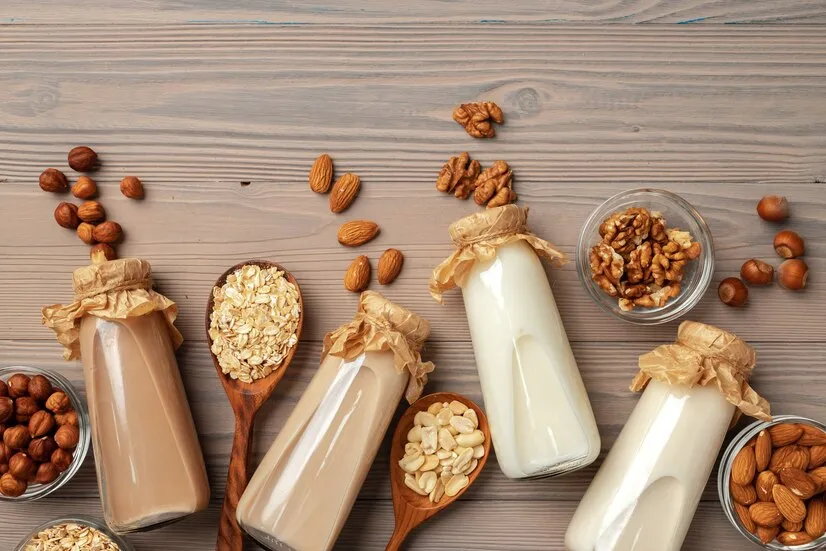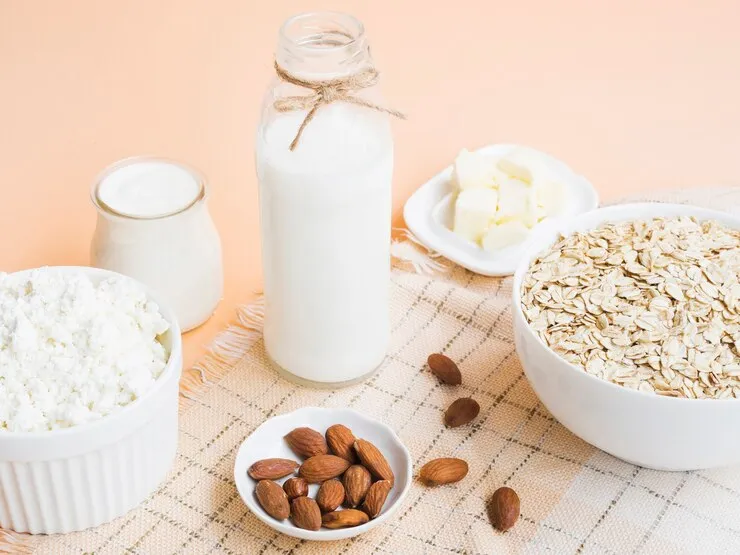Choosing Dairy Free Milk Options: What You Need to Know

- The Rise of Dairy Free Milk Options
- Understanding Your Dairy Free Milk Options
- Nutritional Considerations When Choosing Dairy Free Milk Options
- Environmental Impact of Dairy Free Milk Options
- Taste and Texture: Finding Your Perfect Dairy Free Milk
- Reading Labels: What to Look for in Dairy Free Milk Options
- Making Your Own Dairy Free Milk
- Addressing Common Concerns About Dairy Free Milk Options
- Conclusion
- FAQ
Are you considering making the switch to dairy-free milk? You’re not alone. More and more people are exploring dairy free milk options for various reasons, from dietary restrictions to environmental concerns. In this comprehensive guide, we’ll dive into everything you need to know about choosing the right dairy-free milk for your needs.
The Rise of Dairy Free Milk Options
Gone are the days when milk exclusively meant cow’s milk. Today, the market is brimming with a variety of dairy free milk options. These plant-based alternatives have gained immense popularity over the past decade, and for good reason.
Dairy free milk options offer a wealth of benefits. They cater to those with lactose intolerance or milk allergies, provide alternatives for vegans and vegetarians, and often boast impressive nutritional profiles. Moreover, many people find that these options align better with their environmental and ethical values.

Understanding Your Dairy Free Milk Options
Let’s explore some of the most popular dairy free milk options available today:
1. Almond Milk
Almond milk is perhaps one of the most well-known dairy free milk options. It’s made by blending almonds with water and then straining the mixture. The result is a light, nutty-flavored milk that’s low in calories and fat.
Pros of almond milk:
- Low in calories
- Naturally rich in vitamin E
- Often fortified with calcium and vitamin D
Cons of almond milk:
- Lower in protein compared to cow’s milk
- May not be suitable for those with nut allergies
- Environmental concerns due to high water usage in almond farming
2. Soy Milk
Soy milk has been a staple dairy free milk option for decades. It’s made from soybeans and water, resulting in a creamy texture similar to cow’s milk.
Pros of soy milk:
- High in protein
- Contains all essential amino acids
- Often fortified with calcium and vitamins
Cons of soy milk:
- Some people may be allergic to soy
- Concerns about phytoestrogens (though research is mixed on their effects)
- Taste may not appeal to everyone
3. Oat Milk
Oat milk has surged in popularity in recent years. It’s made by blending oats and water, then straining the mixture. The result is a creamy, slightly sweet milk that many find pleasant.
Pros of oat milk:
- Naturally sweet flavor
- Contains beta-glucans, which may help lower cholesterol
- Often fortified with calcium and vitamins
Cons of oat milk:
- Higher in calories and carbohydrates than some other options
- May not be suitable for those with gluten sensitivities (unless certified gluten-free)
- Some brands may add oils or thickeners
Read This! Best 10 Oat Milk Powders You Need to Try in 2024
4. Coconut Milk
Coconut milk is known for its rich, creamy texture and distinct tropical flavor. It’s made by blending the flesh of mature coconuts with water.
Pros of coconut milk:
- Rich in medium-chain triglycerides (MCTs)
- Creamy texture makes it great for cooking and baking
- Often fortified with calcium and vitamins
Cons of coconut milk:
- High in saturated fat
- Strong flavor may not be suitable for all uses
- Lower in protein compared to cow’s milk
5. Rice Milk
Rice milk is made by blending cooked rice with water and then straining the mixture. It has a light, sweet flavor and is one of the least allergenic dairy free milk options.
Pros of rice milk:
- Least likely to cause allergies
- Naturally sweet taste
- Often fortified with calcium and vitamins
Cons of rice milk:
- Higher in carbohydrates than other options
- Very low in protein
- Thin texture may not be ideal for all uses
Nutritional Considerations When Choosing Dairy Free Milk Options
When selecting among dairy free milk options, it’s essential to consider their nutritional profiles. Here are some key nutrients to keep in mind:
Protein
Protein is crucial for building and repairing tissues, making enzymes and hormones, and supporting overall health. While cow’s milk is naturally high in protein, not all dairy free milk options match up.
Soy milk typically contains the most protein among plant-based options, with about 7-8 grams per cup. Pea milk, a newer option, also offers comparable protein content. Other dairy free milk options like almond, oat, and rice milk generally contain less protein, usually 1-3 grams per cup.
Calcium
Calcium is essential for bone health, muscle function, and nerve signaling. Many dairy free milk options are fortified with calcium to match the levels found in cow’s milk.
When choosing a dairy free milk, look for options fortified with calcium. Aim for about 300-400 mg per cup, which is comparable to cow’s milk.
Vitamin D
Vitamin D works hand in hand with calcium to support bone health. It also plays crucial roles in immune function and mood regulation.
Like calcium, many dairy free milk options are fortified with vitamin D. Look for options that provide about 15-20% of the daily value per serving.
Other Nutrients
Depending on the base ingredient and fortification, dairy free milk options can provide various other nutrients:
- Vitamin B12: Often added to plant-based milks, as it’s naturally found only in animal products.
- Vitamin E: Naturally high in almond milk.
- Omega-3 fatty acids: Found in some varieties of flax milk or hemp milk.

Environmental Impact of Dairy Free Milk Options
As consumers become more environmentally conscious, the ecological footprint of our food choices has come under scrutiny. Dairy free milk options generally have a lower environmental impact than cow’s milk, but there are differences among them.
Water Usage
Water usage varies significantly among dairy free milk options:
- Almond milk requires the most water to produce, with each almond needing about 1.1 gallons of water.
- Oat milk and soy milk generally require less water than almond milk.
- Rice milk also requires substantial water for cultivation.
Land Use
Land use is another important consideration:
- Soy and oat farming generally require less land than dairy farming.
- Coconut production can have complex land use implications, including potential deforestation concerns.
Greenhouse Gas Emissions
In terms of greenhouse gas emissions:
- All plant-based milk options generally produce fewer emissions than cow’s milk.
- Rice milk has higher emissions compared to other plant-based options due to methane produced in rice paddies.
It’s worth noting that while these are general trends, the exact environmental impact can vary based on production methods, transportation, and packaging.
Taste and Texture: Finding Your Perfect Dairy Free Milk
While nutritional content and environmental impact are important, let’s not forget about taste and texture. After all, you’re likely to stick with an option you enjoy.
Taste Profiles
- Almond milk: Light, nutty flavor
- Soy milk: Mild, slightly beany taste
- Oat milk: Sweet, oaty flavor
- Coconut milk: Rich, tropical taste
- Rice milk: Light, sweet flavor
Texture Considerations
- For coffee: Oat milk and soy milk tend to foam well for lattes.
- For cereal: Any option works, but rice milk and almond milk have lighter textures.
- For cooking: Coconut milk and soy milk hold up well to heat.
- For baking: Oat milk and soy milk often work as direct substitutes for cow’s milk.
Remember, tastes can vary between brands. Don’t be afraid to experiment to find your favorite!
Reading Labels: What to Look for in Dairy Free Milk Options
When shopping for dairy free milk options, it’s crucial to read labels carefully. Here’s what to look out for:
Added Sugars
Some dairy free milk options contain added sugars to enhance flavor. If you’re watching your sugar intake, opt for unsweetened varieties.
Additives
Look out for additives like carrageenan, which some people prefer to avoid. Many brands now offer options without this ingredient.
Fortification
Check for added calcium, vitamin D, and vitamin B12, especially if you rely on your plant-based milk as a significant source of these nutrients.
Organic and Non-GMO Labels
If these are important to you, look for USDA Organic or Non-GMO Project Verified labels.
Making Your Own Dairy Free Milk
For the DIY enthusiasts, many dairy free milk options can be made at home. This allows you to control the ingredients and avoid additives. Here’s a simple recipe for almond milk:
- Soak 1 cup of raw almonds in water overnight.
- Drain and rinse the almonds.
- Blend the almonds with 4 cups of fresh water.
- Strain the mixture through a nut milk bag or cheesecloth.
- Add a pinch of salt and any desired flavoring (like vanilla extract).
Homemade milk typically lasts 3-5 days in the refrigerator.
Addressing Common Concerns About Dairy Free Milk Options
As with any dietary change, switching to dairy free milk options can raise some questions and concerns. Let’s address some common ones:
“Are dairy free milk options nutritionally adequate?”
While plant-based milks differ nutritionally from cow’s milk, they can be part of a healthy diet. Many are fortified to provide similar nutrients. However, it’s important to consider your overall diet to ensure you’re meeting all your nutritional needs.
“Can children drink dairy free milk?”
Many children can thrive on dairy free milk options, but it’s crucial to choose ones that are fortified and provide adequate nutrition. Always consult with a pediatrician before making significant changes to a child’s diet.
“Will I get enough calcium without dairy?”
Many dairy free milk options are fortified with calcium. Additionally, calcium can be obtained from other sources like leafy greens, fortified foods, and some types of fish.
“Are dairy free milk options more expensive?”
While prices can vary, some dairy free milk options may be more expensive than cow’s milk. However, the cost difference has decreased as these products have become more mainstream.
Conclusion
The world of dairy free milk options is vast and exciting. Whether you’re making the switch for health reasons, ethical concerns, or simply out of curiosity, there’s likely a plant-based milk out there that suits your needs and tastes.
Remember, the “best” dairy free milk option depends on your individual nutritional needs, taste preferences, and how you plan to use it. Don’t be afraid to experiment with different types and brands to find your perfect match.
As we continue to innovate in the world of food and beverage, who knows what new dairy free milk options might emerge in the future? The key is to stay informed, read labels, and make choices that align with your personal health goals and values.
FAQ
- Q: Are dairy free milk options suitable for people with nut allergies?
A: It depends on the specific milk. While nut-based options like almond milk should be avoided, alternatives like oat milk, rice milk, and soy milk are generally safe for those with nut allergies. Always check labels and consult with a healthcare provider if you have concerns. - Q: How do dairy free milk options compare to cow’s milk in terms of calcium content?
A: Many dairy free milk options are fortified with calcium to match or exceed the levels found in cow’s milk. However, it’s important to check labels, as not all brands fortify their products. Look for options that provide about 300-400 mg of calcium per cup. - Q: Can dairy free milk options be used in cooking and baking?
A: Yes, dairy free milk options can often be used as direct substitutes in cooking and baking. However, the results may vary depending on the recipe and the specific milk used. Soy milk and oat milk often work well as all-purpose substitutes due to their neutral flavor and creamy texture. - Q: Are dairy free milk options more environmentally friendly than cow’s milk?
A: Generally, dairy free milk options have a lower environmental impact than cow’s milk in terms of water use, land use, and greenhouse gas emissions. However, the exact impact varies among different plant-based options. For example, almond milk requires more water to produce than oat or soy milk. - Q: How long do dairy free milk options last once opened?
A: Most commercially produced dairy free milk options last about 7-10 days in the refrigerator once opened. Homemade versions typically last 3-5 days. Always check for signs of spoilage and follow the storage instructions on the package.



